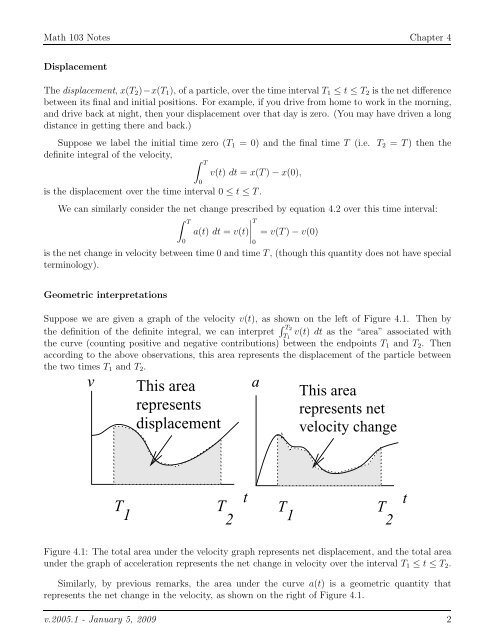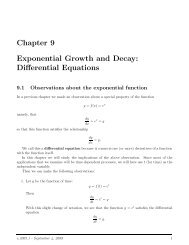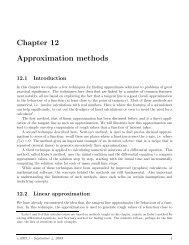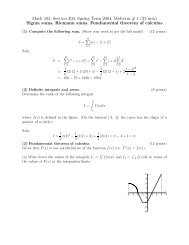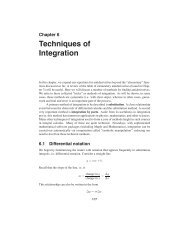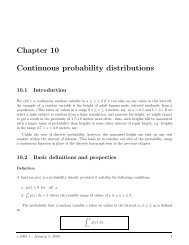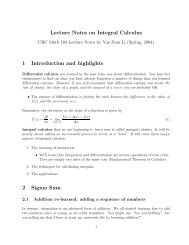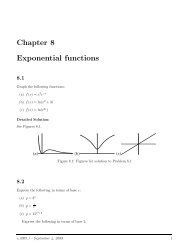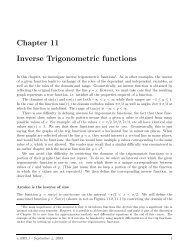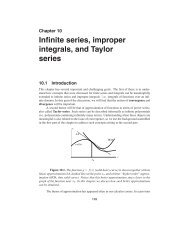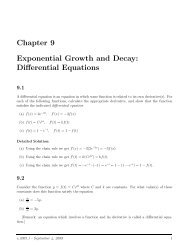Chapter 4 Applications of the definite integral to rates, velocities and ...
Chapter 4 Applications of the definite integral to rates, velocities and ...
Chapter 4 Applications of the definite integral to rates, velocities and ...
Create successful ePaper yourself
Turn your PDF publications into a flip-book with our unique Google optimized e-Paper software.
Math 103 Notes <strong>Chapter</strong> 4DisplacementThe displacement, x(T 2 )−x(T 1 ), <strong>of</strong> a particle, over <strong>the</strong> time interval T 1 ≤ t ≤ T 2 is <strong>the</strong> net differencebetween its final <strong>and</strong> initial positions. For example, if you drive from home <strong>to</strong> work in <strong>the</strong> morning,<strong>and</strong> drive back at night, <strong>the</strong>n your displacement over that day is zero. (You may have driven a longdistance in getting <strong>the</strong>re <strong>and</strong> back.)Suppose we label <strong>the</strong> initial time zero (T 1 = 0) <strong>and</strong> <strong>the</strong> final time T (i.e. T 2 = T) <strong>the</strong>n <strong>the</strong><strong>definite</strong> <strong>integral</strong> <strong>of</strong> <strong>the</strong> velocity,∫ T0v(t) dt = x(T) − x(0),is <strong>the</strong> displacement over <strong>the</strong> time interval 0 ≤ t ≤ T.We can similarly consider <strong>the</strong> net change prescribed by equation 4.2 over this time interval:∫ TTa(t) dt = v(t)∣ = v(T) − v(0)0is <strong>the</strong> net change in velocity between time 0 <strong>and</strong> time T, (though this quantity does not have specialterminology).0Geometric interpretationsSuppose we are given a graph <strong>of</strong> <strong>the</strong> velocity v(t), as shown on <strong>the</strong> left <strong>of</strong> Figure 4.1. Then by<strong>the</strong> definition <strong>of</strong> <strong>the</strong> <strong>definite</strong> <strong>integral</strong>, we can interpret ∫ T 2T 1v(t) dt as <strong>the</strong> “area” associated with<strong>the</strong> curve (counting positive <strong>and</strong> negative contributions) between <strong>the</strong> endpoints T 1 <strong>and</strong> T 2 . Thenaccording <strong>to</strong> <strong>the</strong> above observations, this area represents <strong>the</strong> displacement <strong>of</strong> <strong>the</strong> particle between<strong>the</strong> two times T 1 <strong>and</strong> T 2 .vThis arearepresentsdisplacementaThis arearepresents netvelocity changeT 1T2tT 1T2tFigure 4.1: The <strong>to</strong>tal area under <strong>the</strong> velocity graph represents net displacement, <strong>and</strong> <strong>the</strong> <strong>to</strong>tal areaunder <strong>the</strong> graph <strong>of</strong> acceleration represents <strong>the</strong> net change in velocity over <strong>the</strong> interval T 1 ≤ t ≤ T 2 .Similarly, by previous remarks, <strong>the</strong> area under <strong>the</strong> curve a(t) is a geometric quantity thatrepresents <strong>the</strong> net change in <strong>the</strong> velocity, as shown on <strong>the</strong> right <strong>of</strong> Figure 4.1.v.2005.1 - January 5, 2009 2


